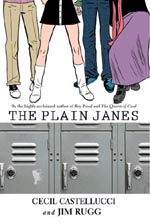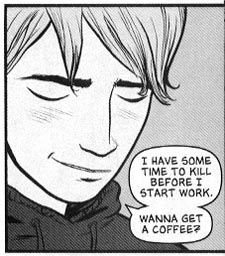 Written by Cecil Castellucci
Written by Cecil Castellucci
Art by Jim Rugg
176 pages, black and white
Published by Minx/DC Comics
There’s a big difference between a plot synopsis and the actual finished product. So often, the two end up mismatched, with one of them being lackluster and the other being fantastic. Ideally, you want the two to be on equal footing, but in the case of books like Cecil Castellucci’s and Jim Rugg’s The Plain Janes that’s not always the end result. For what was the big initial launch book for DC Comics’s new Minx line, that can be a little worrisome, because no matter if it was the idea or the execution that fell down, somewhere along the way you run the risk of scaring off potential readers.
When a terrorist attack strikes Metro City, Jane’s parents decide it’s time to uproot their lives and move to Kent Waters, a bit of suburbia where nothing ever happens. Jane’s life is changing in a different way, though, and she’s not willing to do what is expected of her by her family or peers. Banding together with three other “outsider” girls named Jane, Jayne, and Polly Jane, they’re ready to start rebelling in the form of unannounced art all through Kent Waters. But will these pieces of art unify her classmates and the town, or end up dividing people further?
At a glance, The Plain Janes seemed like it would be a fun, clever little book. Jane’s “art attacks” throughout Kent Waters are really clever and inventive, enough to boost the slightly overused “outsiders band together against the rest of the school” storyline that is seen so often in all forms of media. It’s only when you get a little further into the book that you realize that the art (in more ways than one) is all The Plain Janes really has going for it. Castellucci seems to have spent so much time coming up with neat ideas for Jane and the rest of the People Loving Art In Neighborhoods (PLAIN) to create that everything else seems to have fallen to the wayside. No characters other than “main” Jane are developed beyond a two word description. Sports player. Actor. Science geek. Popular princess. Gay outcast. While it’s fine for these to be used as the absolute base for a character’s personality, there’s nothing ever added onto them; the cast is so one-dimension that it makes the two-dimensional protagonist seem positively rich in comparison. Unfortunately, that’s not the only problem with The Plain Janes. The plot itself seems to suddenly, abruptly lurch to a halt. Things begin to build, start moving towards a climax, and then with no warning stop as if an arbitrary page count was hit and the book had to end. Then again, even a lot of the plot developments seem to transition awkwardly across the page; the town’s “anti-art” stance never comes across as believable other than for the sake of a conflict, and people seem to switch sides and come on board for the sake of story convenience than any actual motivation. This is admittedly Castellucci’s first journey into comics (better known for her prose novels) but even then, it feels like this was a less-than-successful initial attempt.
 On the bright side, the earlier statement about the art of The Plain Janes being all the book had going for it was referring not only to the art within the plot, but the actual art itself by Rugg. His art is perky and fun, with clean character designs and lines. He manages to sell Castellucci’s art attack ideas by making them both fantastical and real simultaneously; you believe that the Janes could have built their rock-pile-pyramids, for example, and the horde of stuffed animals outside the animal shelter are funny and cute to look at. It’s not a flashy or experimental style, just one that focuses on solid storytelling and brings the message across as best it can.
On the bright side, the earlier statement about the art of The Plain Janes being all the book had going for it was referring not only to the art within the plot, but the actual art itself by Rugg. His art is perky and fun, with clean character designs and lines. He manages to sell Castellucci’s art attack ideas by making them both fantastical and real simultaneously; you believe that the Janes could have built their rock-pile-pyramids, for example, and the horde of stuffed animals outside the animal shelter are funny and cute to look at. It’s not a flashy or experimental style, just one that focuses on solid storytelling and brings the message across as best it can.
In many ways reading The Plain Janes is an exercise in frustration. You want to like it. It seems like you should. The problem is, the book’s basic premise and the actual end result don’t match up. It’s a shame, but just because you want something to succeed doesn’t mean it necessarily will. At least the book brought a whole lot of new Rugg art into the world, though. For that alone, you can’t dismiss it entirely. But it’s by no means a good start to the Minx book line.
Purchase Links:
